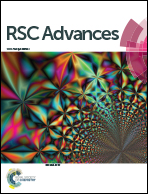Is the bioconformation of 5-deoxy-5-fluoro-d-xylulose affected by intramolecular hydrogen bonds?†
Abstract
5-Deoxy-5-fluoro-D-xylulose (DFX) binds to the xylulokinase enzyme and, as a free ligand, it has preferential conformations governed by intramolecular interactions, such as hydrogen bonds and hyperconjugative interactions. The role of intramolecular hydrogen bonds on the bioconformation of DFX has not been studied yet, despite the relevance of this topic to explain the mode of interaction between the ligand and enzyme and, therefore, the action mechanism of this molecule. DFX presents several conformations in the gas phase and implicit water, as determined by theoretical calculations, but the main optimized geometries do not match the bioactive conformation nor the most stable docked structure. This indicates that even expected strong interactions, such as hydrogen bonds, are overcome by the enzyme induced fit of DFX. The natural consequence of this finding in three-dimensional quantitative structure–activity relationship (3D-QSAR) analysis is that the use of conformations obtained in a receptor-free environment can cause misinterpretation of the chemical and biological results.



 Please wait while we load your content...
Please wait while we load your content...